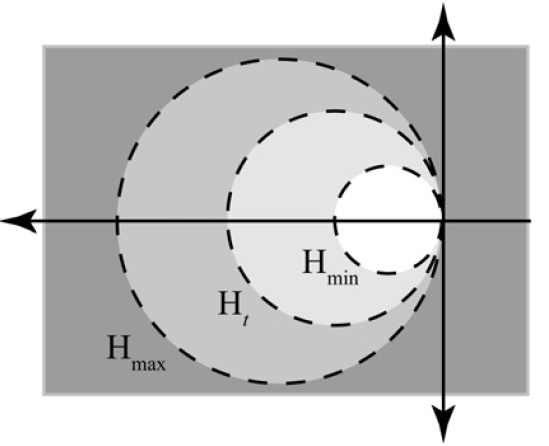Unilateral Laplace transform
Let $\mathbb{T}$ be a time scale and let $s \in \mathbb{T}$. If $f \in C_{rd}(\mathbb{T},\mathbb{C})$ ( rd-continuous) then we define the Laplace transform of $f$ about $s$ by the formula [pp.793] $$\mathscr{L}\{f\}(z;s) = \displaystyle\int_s^{\infty} f(t) e_{\ominus z}(\sigma(t),s) \Delta t,$$ where $z$ is in a domain $D \subset \mathbb{C}$ for which the integral converges. Let $\alpha$ be a non-negative regressive constant larger than $s$. We use the notation "$f(t;s)$" to denote we are thinking of $f$ as a function of $t$ with parameter $s$.
Table of Laplace transforms
| $\mathbb{T}=$ | $\mathscr{L}_{\mathbb{T}}\{f\}(z;s)=$ |
| $\mathbb{R}$ | $\mathscr{L}_{\mathbb{R}}\{f\}(z;s)=\displaystyle\int_s^{\infty} f(\tau) e^{-z\tau} d\tau$ |
| $\mathbb{Z}$ | |
| $h\mathbb{Z}$ | |
| $\mathbb{Z}^2$ | |
| $\overline{q^{\mathbb{Z}}}, q > 1$ | |
| $\overline{q^{\mathbb{Z}}}, q < 1$ | |
| $\mathbb{H}$ |
| Function $f(t;s)$ | Laplace Transformation $\mathscr{L}\{f(\cdot;s)\}(z)$ |
| $e_{\alpha}(t;s)$ | $\dfrac{1}{z-\alpha}$ |
| $h_n(t;s)$ | $\dfrac{1}{z^{n+1}}$ |
| $\sinh_{\alpha}(t;s)$ | $\dfrac{\alpha}{z^2-\alpha^2}$ |
| $\cosh_{\alpha}(t;s)$ | $\dfrac{z}{z^2-\alpha^2}$ |
| $\sin_{\alpha}(t;s)$ | $\dfrac{\alpha}{z^2+\alpha^2}$ |
| $\cos_{\alpha}(t;s)$ | $\dfrac{z}{z^2+\alpha^2}$ |
Properties of Laplace Transforms
Proposition: The Laplace transform is linear, i.e. for constants $\alpha, \beta$ and Laplace-transformable functions $f,g$, [pp.795] $$\mathscr{L}\{\alpha f + \beta g\} = \alpha \mathscr{L}\{f\} + \beta \mathscr{L}\{g\}.$$
Proof: █
Proposition: The following formula holds: $$e_{\ominus z}(\sigma(t),s) = \dfrac{e_{\ominus z}(t,s)}{1+\mu(t)z} = -\dfrac{(\ominus z)(t)}{z} e_{\ominus z}(t,s).$$
Proposition: The Laplace transform of a delta derivative: $$\mathscr{L}\{f^{\Delta}\}(z;s) = -f(s) + z\mathscr{L}\{f\}(z).$$
Proof: Compute using integration by parts, $$\begin{array}{ll} \mathscr{L}\{f^{\Delta}\}(z) &= \displaystyle\int_0^{\infty} f^{\Delta}(\tau) e_{\ominus z}(\sigma(\tau),s) \Delta \tau \\ &= \end{array}$$ proving the claim. █
Assume there exist $M,\alpha > 0$ with $$|a_k| \leq M \alpha_k$$ for all $k=0,1,2,\ldots$. Then for all $z$ where it exists, [pp.796] $$\mathscr{L}\left\{ \displaystyle\sum_{k=0}^{\infty} a_k h_k(\cdot,s) \right\}(z;s) = \displaystyle\sum_{k=0}^{\infty} a_k \mathscr{L}\{h_k(\cdot,s)\}(z;s) = \displaystyle\sum_{k=0}^{\infty} \dfrac{a_k}{z^{k+1}},$$ where $h_k$ denotes the standard time scale polynomial.
Proposition: Let $m_z(t,s):=\displaystyle\int_s^t \dfrac{\Delta \tau}{1+\mu(\tau)z}$. Then [pp.797] $$\dfrac{d}{dz} \mathscr{L}\{f\}(z;s) = -\mathscr{L}\{m_z(\sigma(\cdot),s)f\}(z;s).$$
Proof: █
It is known that $\dfrac{d}{dz} e_z(t,t_0) = m_z(t,t_0)e_z(t,t_0)$ and $\dfrac{d}{dz} e_{\ominus z}(t,t_0)=-m_z(t,t_0)e_{\ominus z}(t,t_0)$. These formulas are analogues of the formulas $\dfrac{d}{dz} e^{z(t-t_0)}=(t-t_0)e^{z(t-t_0)}$ and $\dfrac{d}{dz} e^{-z(t-t_0)}=-(t-t_0)e^{-z(t-t_0)}$ which occur in the case $\mathbb{T}=\mathbb{R}$. An important difference from the classical case is that $t-t_0$ has no dependence on the variable $z$, while $m_z(t,t_0)$ does.
Convergence
We define the minimal graininess function $$\mu_*(s)=\inf_{\tau \in [s,\infty) \cap \mathbb{T}} \mu(\tau).$$ Let $h\geq 0$. We also define the Hilger real part of $z \in \mathbb{C}$ by $$\mathrm{Re}_h(z)=\dfrac{1}{h}(|1+hz|-1)$$ and the Hilger imaginary part of $z \in \mathbb{C}$ by $$\mathrm{Re}_h(z)=\mathrm{Arg}(1+hz),$$ where $\mathrm{Arg}$ denotes the principal argument of $1+hz$. We let $$\mathbb{C}_h = \left\{ z \in \mathbb{C} \colon z \neq -\dfrac{1}{h} \right\}.$$ Finally given some $\lambda \in \mathbb{R}$ we define $$\mathbb{C}_h(\lambda) = \left\{ z \in \mathbb{C}_h \colon \mathrm{Re}_h(z) > \lambda \right\}.$$
Theorem (Absolute convergence): Let $f \in C_{\mathrm{rd}}([s,\infty) \cap \mathbb{T},\mathbb{C})$ be of exponential order $\alpha$. Then $\mathscr{L}\{f\}(\cdot;s)$ exists on $\mathbb{C}_{\mu_*(s)}(\alpha)$ and converges absolutely.
Proof: █
Theorem (Uniform convergence): Let $f \in C_{\mathrm{rd}}([s,\infty)\cap\mathbb{T},\mathbb{C})$ be of exponential order $\alpha$. Then the Laplace transform $\mathscr{L}\{f\}$ converges uniformly in the half-plane $C_{\mu_*(s)}(\beta)$ for any $\beta > \alpha$.
Proof: █
Inverse Transform on isolated time scales
The following information is from pp.##. Define the notation $$\mathrm{Re}_h(z) := \dfrac{1}{h} (|1+hz|-1).$$ Let $\mathbb{T}$ be a time scale with $0 < \mu_{\mathrm{min}} \leq \mu(t) \leq \mu_{\mathrm{max}} < \infty.$ Let $\mu_* := \mu_{\mathrm{min}}$ and $\mu^* := \mu_{\mathrm{max}}$. Define in $\mathbb{C}$ the Hilger circles $$\mathbb{H}_{\mu(t)} = \left\{ z \in \mathbb{C} \colon 0 < \left| z + \dfrac{1}{\mu(t)} \right| < \dfrac{1}{\mu(t)} \right\},$$ which are disks centered at $\left(-\dfrac{1}{\mu(t)},0 \right)$ with radius $\dfrac{1}{\mu(t)}$.
These circles define the region of convergence for the Laplace transform $\mathscr{L}_\mathbb{T}$. If $\mu_*=0$, then the region of convergence is the right half plane, but if $\mu_*>0$ the region of convergence is outside of $\mathbb{H}_{\mu_*}$.
Theorem: Suppose that $F(z)$ is analytic in the region $\mathrm{Re}_{\mu}(z)>\mathrm{Re}_{\mu}(c)$ and $F(z) \rightarrow 0$ uniformly as $|z| \rightarrow \infty$ in this region. Suppose $F(z)$ has finitely many regressive poles of finite order $\{z_1,\ldots,z_n\}$ and $\tilde{F}_{\mathbb{R}}(z)$ is the transform of the function $\tilde{f}(t)$ on $\mathbb{R}$ that corresponds to the transform $F(z)=F_{\mathbb{T}}(z)$ of $f(t)$ on $\mathbb{T}$. If $$\displaystyle\int_{c-i\infty}^{c+i\infty} |\tilde{F}_{\mathbb{R}}(z)||dz|<\infty,$$ then $$f(t)=\displaystyle\sum_{i=1}^n \mathrm{Res}_{z=z_i} e_z(t,0) F(z)$$ has transform $F(z)$ for all $z$ with $\mathrm{Re}(z)>c$.
Proof: █
See also
References
- Martin Bohner and Başak Karpuz: The gamma function on time scales (2013)... (next): Section 3
